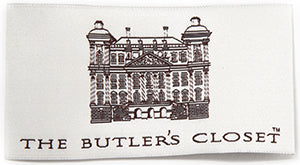The Butler's Tour at Biltmore is Extraordinary!
As I mentioned in my previous blog entry, my husband and I visited the Biltmore Estate in Asheville, North Carolina and in addition to the regular house tour signed up for The Butler's Tour to see the servants quarters, kitchens and other non-public areas.
Biltmore is the largest privately owned home in the United States and is still in the hands of the Vanderbilt family. The mansion was built by George Washington Vanderbilt III and encompasses four acres of floor space and 250 rooms -- 33 family and guest bedrooms, 43 bathrooms, 65 fireplaces, three kitchens and an indoor swimming pool.

The Biltmore Estate in Asheville, North Carolina
One of the most interesting aspects of the tour was discovering how George Vanderbilt incorporated the modern technology of the day.
In 1890 electricity was gaining popularity, replacing oil and gas lamps. Biltmore is fully electrified and during our tour we saw the original, enormous and impressive, electrical control panel that worked successfully until early in this new century. Large black switches controlled different electrical zones and the power was sufficient to support even many of the modernizations and upgrades that took place over the decades. To prove this, our guide pointed out the plastic labels that were affixed underneath each large switch to show its recent use.
My husband, who is an architect, was very impressed with the organization of the plan of the house and the use of labor-saving techniques. At the start of the tour we walked up steep, curving flights of stairs and came out to a balcony that overlooked the large service courtyard. Suppliers to the household unloaded everything at this entrance--coal, vegetables, meat, poultry, and other necessities. There were manhole covers that opened to receive coal that went to the basement where the furnace was stoked 24 hours per day by workmen shoveling coal into it's roaring mouth.
Food was taken directly to the enormous suite of rooms that comprised the numerous kitchens and larder. Biltmore has a pastry kitchen, a roasting kitchen, a main kitchen, a scullery for dishwashing and many very large separate rooms to house vegetables, canned goods and other foods. Walk-in refrigerators were built in to receive and cool fresh eggs, milk, cheeses and other items that required cooling. From the courtyard entrance furniture was arranged in the caged elevator to transport it to the upper floors.
Trunks of clothing for the household or their guests were loaded here as well and the lady's maids and valets then were dispatched to the rooms of their employer to unpack the clothing from the trunks, press articles as needed, and lay out the clothing for the next activity. After viewing this courtyard entrance from a high balcony, we then stepped into the office of the housekeeper who worked for the Vanderbilts, Mrs. King.
Unlike the Stately Homes in Great Britain, where the butler had the most senior position in the household, in Asheville at the Biltmore, Mrs. King, who was English, ruled supreme. In her office we saw furniture covered with loose fabric—to keep dust away, and with tyvek (a material used to wrap houses after they are insulated that is used by conservators).
On display were numerous cleaning items including a vacuum from Bissel (a company still in business today), a small bellows to keep the coal fire going, a wooden carrier for cleaning supplies and, most interesting of all, a long fox tail affixed to a handle that was used to dust in harder to reach places.
This fascinating tour continued as we saw the Butler's pantry where food was brought up from the kitchen below on a dumb waiter, plated and taken into the main dining room or put on to breakfast trays that were taken up to the married women who were having breakfast in bed. As Asheville is deep in the Blue Ridge Mountains, accessible at that time by carriage, guests came and stayed for long visits.
Ladies and gentlemen traveled with endless amounts of clothing as they changed outfits a minimum of three times per day. We saw some century old Louis Vuitton traveling chests that had room to hang many long evening gowns and drawers for gloves, undergarments, etc. Guests, male and female, would travel with numerous trunks filled to the brim with changes of clothing. Their servants, a lady's maid or valet, would accompany them on the journey and take responsibility for the maintenance of his or her employer's wardrobe.
More about this tour coming in a future blog entry.
